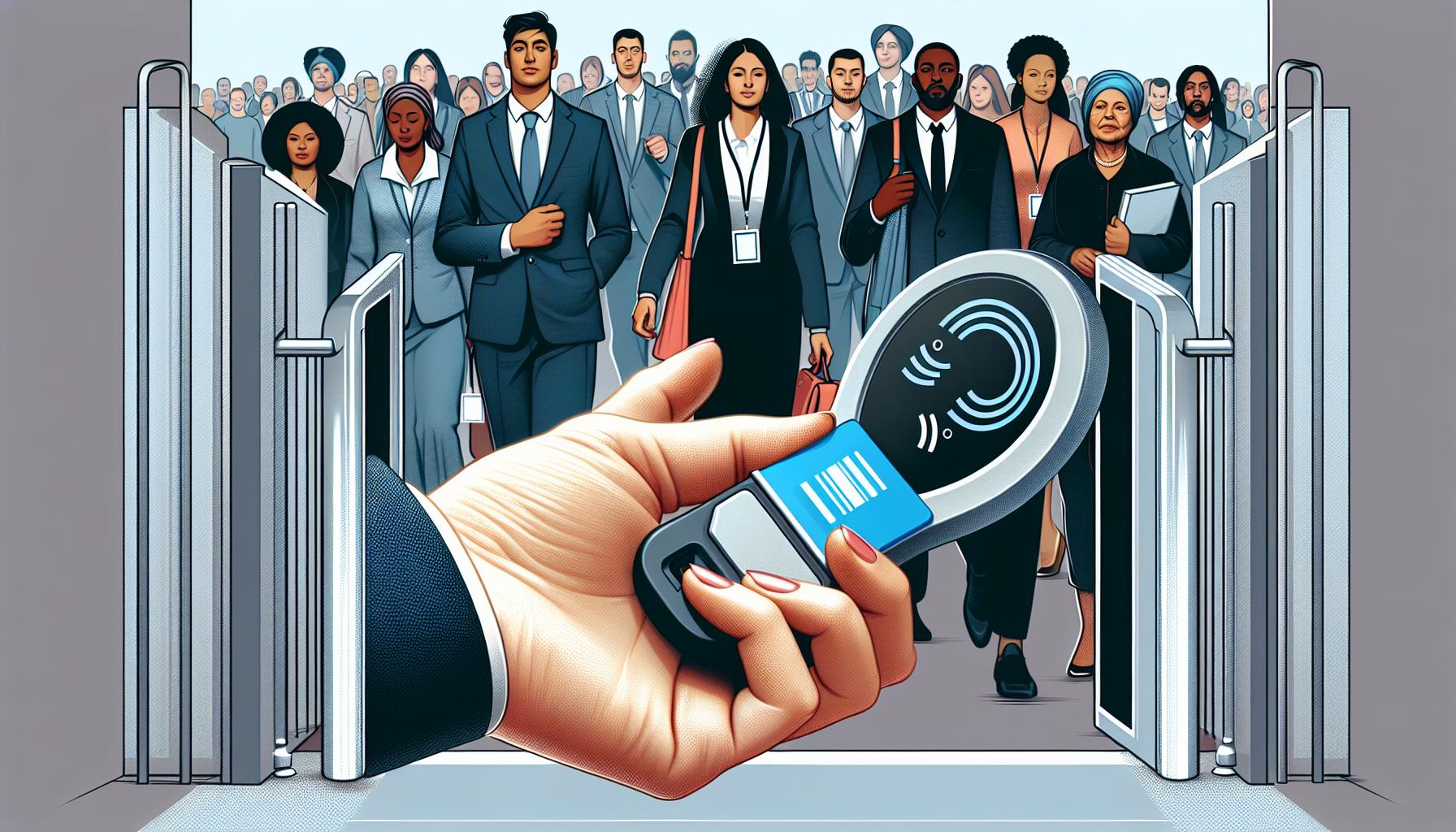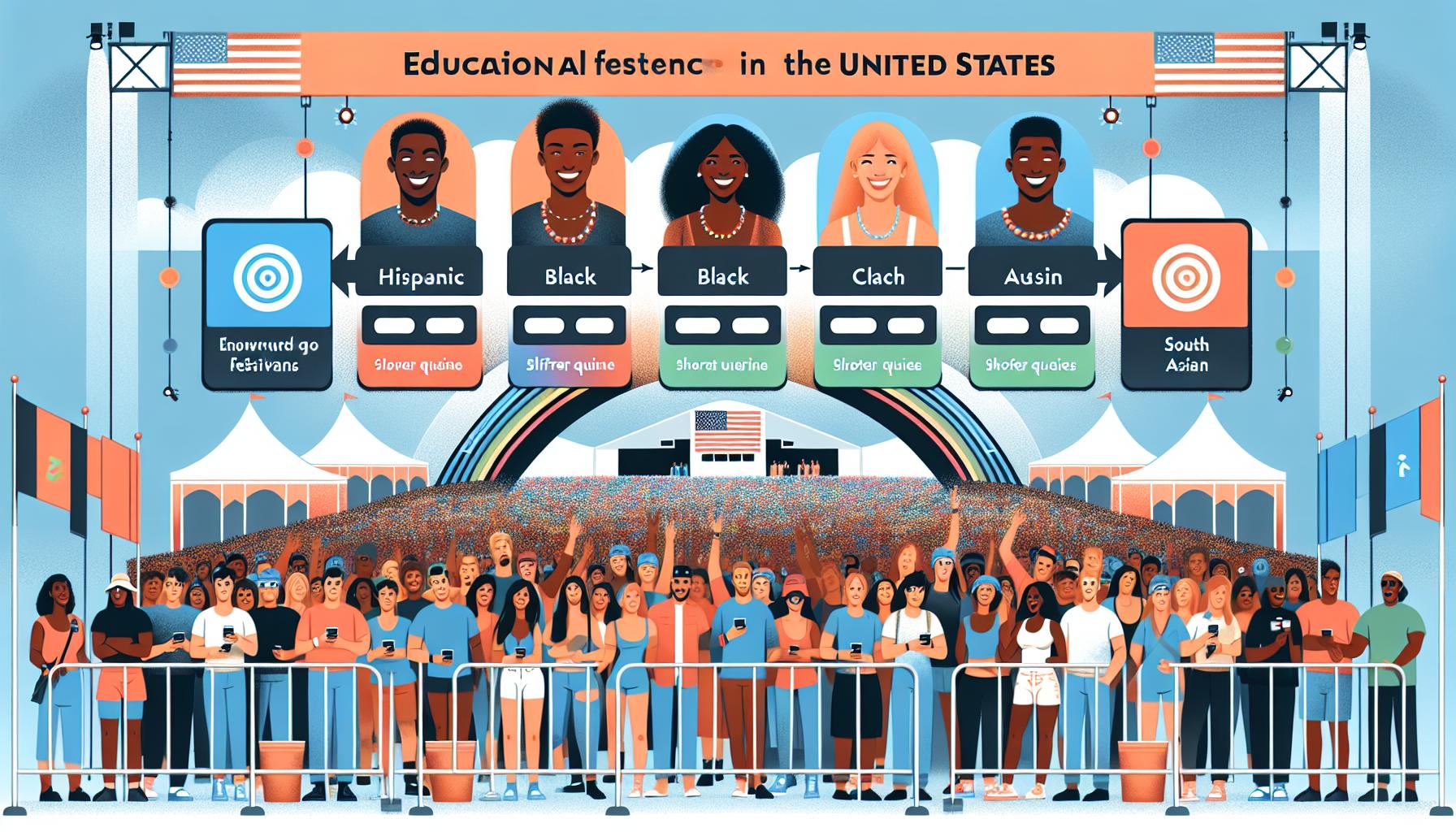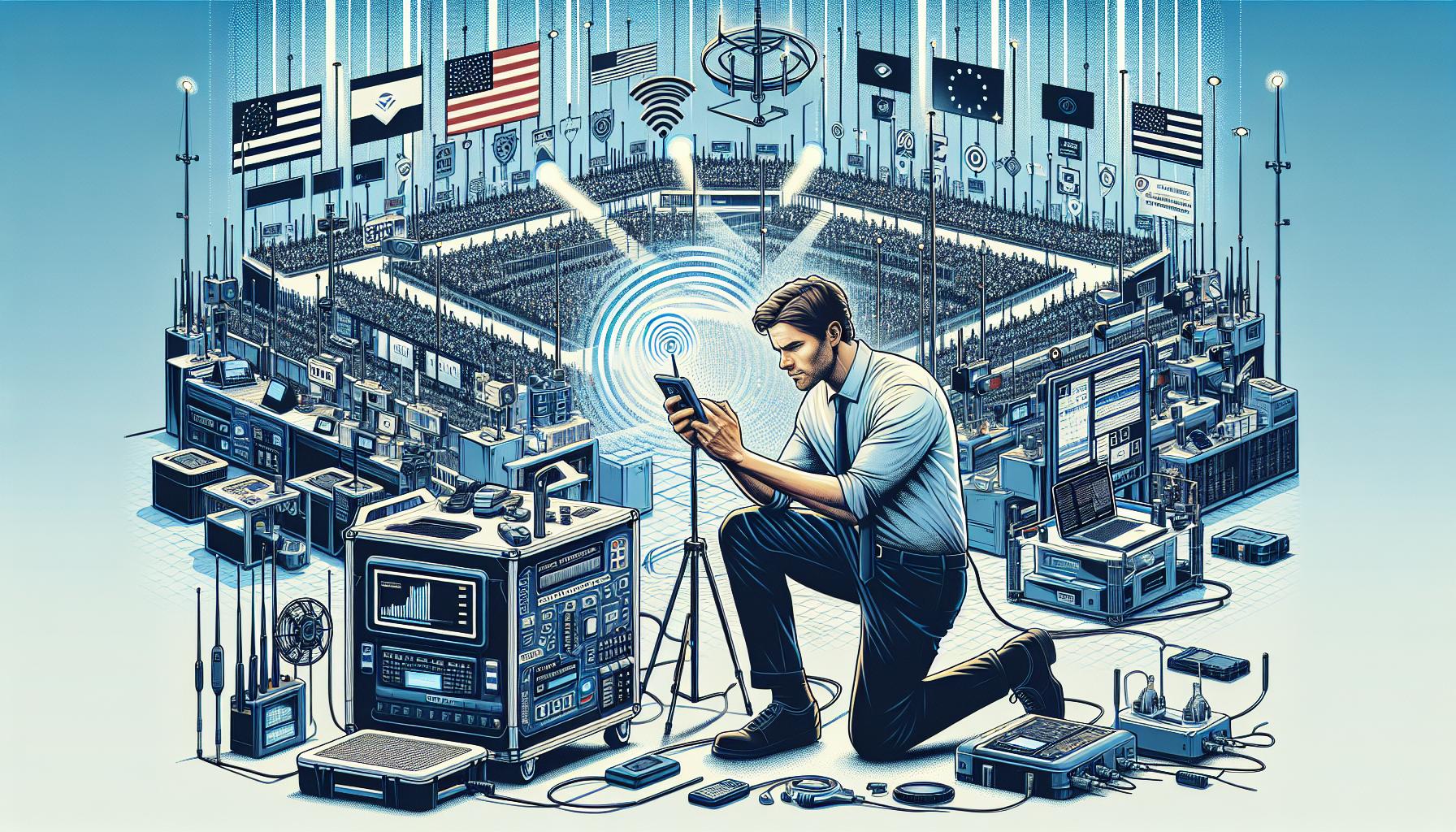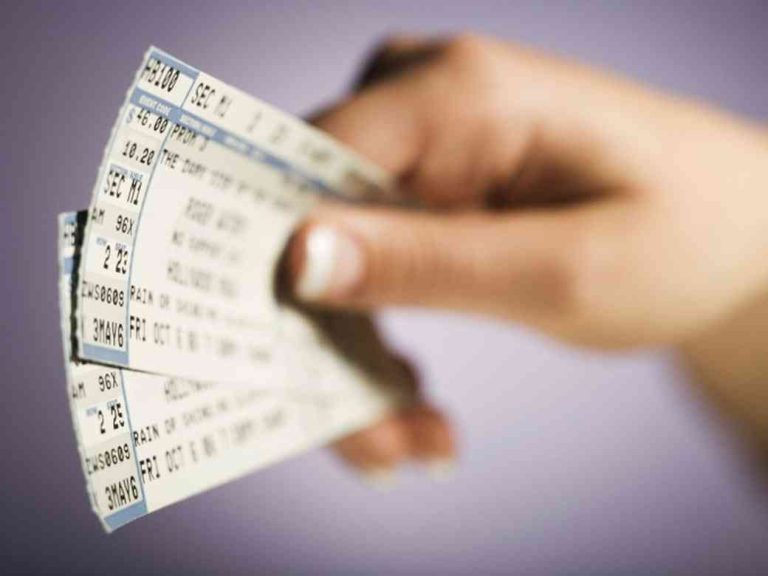Are you looking to streamline your event management and enhance attendee experience? RFID technology might be the game-changer you’ve been waiting for. With its ability to revolutionize on-site payments and access control, RFID is transforming the way events are organized and enjoyed.
Imagine a world where your attendees can breeze through entry points and make purchases with a simple wave of a wristband or card. That’s the power of RFID in action. By implementing this cutting-edge technology, you’ll not only boost efficiency but also gather valuable data to improve future events. Let’s dive into how RFID can elevate your event management strategy and create unforgettable experiences for your guests.
Key Takeaways
- RFID technology streamlines event management by enabling contactless payments and efficient access control
- Implement RFID systems with wristbands, readers, and backend software for seamless transactions and entry
- Enhance security and gather real-time data analytics to improve future event planning and attendee experiences
- Provide faster transactions, reduced wait times, and personalized experiences for event attendees
- Stay ahead with emerging trends like wearable RFID devices, biometric integration, and AI-powered analytics
Understanding RFID Technology for Events
RFID technology revolutionizes event management by enabling seamless on-site payments and access control. Explore the key aspects of RFID and its applications in event settings.
What Is RFID and How Does It Work?
RFID (Radio-Frequency Identification) uses electromagnetic fields to automatically identify and track tags attached to objects. In event scenarios, RFID systems consist of three main components:
- RFID tags: Small chips embedded in wristbands, cards, or badges
- RFID readers: Devices that emit radio waves to communicate with tags
- Backend system: Software that processes and stores data from reader-tag interactions
RFID tags contain unique identifiers, allowing for quick and accurate data transmission when scanned by readers. This technology enables:
- Contactless transactions: Attendees make purchases by waving their RFID-enabled wristband near a reader
- Efficient access control: Quick entry and exit at event venues
- Real-time tracking: Monitoring attendee movement and engagement throughout the event
Differences Between RFID and NFC
While both RFID and NFC (Near Field Communication) use radio-frequency technology, they have distinct characteristics:
| Feature | RFID | NFC |
|---|---|---|
| Range | Up to 100 meters | Up to 10 centimeters |
| Data transfer | One-way (tag to reader) | Two-way communication |
| Power source | Passive or active tags | Passive tags only |
| Frequency | Low, high, or ultra-high | High frequency only |
| Applications | Inventory tracking, access control | Mobile payments, data sharing |
RFID’s longer read range and one-way communication make it ideal for large-scale event management, while NFC’s short-range, two-way capabilities suit mobile payment systems and personal device interactions.
Implementing RFID for Event Management
Setting Up Cashless Payment Systems
Implement RFID-enabled cashless payment systems to streamline transactions at your event. Start by selecting RFID wristbands or cards that integrate with your chosen payment platform. Program these devices with unique identifiers linked to attendees’ accounts. Install RFID readers at point-of-sale locations throughout the venue, ensuring comprehensive coverage. Train staff on operating the RFID payment system and troubleshooting common issues. Set up a secure server to process transactions and store financial data. Establish a top-up station where attendees can add funds to their RFID devices. Implement real-time monitoring of transactions to detect and prevent fraud. Offer a refund process for unused balances after the event concludes.
Establishing Access Control Measures
Create a robust access control system using RFID technology to enhance security and manage attendee flow. Define different access levels based on ticket types, VIP status, or staff roles. Encode RFID wristbands or cards with appropriate access permissions for each attendee category. Install RFID readers at entry points, restricted areas, and specific zones within the venue. Integrate the RFID system with your event management software to track real-time attendance and occupancy levels. Set up automated alerts for unauthorized access attempts or suspicious activity. Implement a check-in process that activates RFID devices upon attendee arrival. Train security personnel on using handheld RFID readers for mobile verification. Establish a central control station to monitor all access points and respond to any security concerns promptly.
Essential Equipment and Tools

To implement RFID for on-site event payments and access control, you need specific hardware components. These tools form the backbone of your RFID system, enabling seamless transactions and efficient entry management.
RFID Wristbands and Cards
RFID wristbands and cards serve as the primary identification and payment method for event attendees. Choose durable, water-resistant wristbands for multi-day events or outdoor festivals. Opt for cards in professional settings or conferences. Select RFID tags with appropriate frequency ranges:
- Low-frequency (LF) tags: 125-134 kHz, suitable for short-range applications
- High-frequency (HF) tags: 13.56 MHz, ideal for most event scenarios
- Ultra-high-frequency (UHF) tags: 860-960 MHz, for long-range identification
Customize wristbands or cards with event branding, unique identifiers, and security features to prevent counterfeiting.
Readers and Scanners
RFID readers and scanners are essential for processing transactions and verifying access rights. Select equipment based on your event’s specific needs:
- Fixed readers: Install at entry points, exits, and payment stations
- Handheld scanners: Use for mobile ticket verification or roaming vendors
- Smartphone-compatible readers: Enable staff to process payments with mobile devices
Consider these factors when choosing readers:
| Factor | Description |
|---|---|
| Read range | Distance at which tags can be detected (6 inches to 30 feet) |
| Compatibility | Ensure readers work with your chosen RFID tags |
| Processing speed | Ability to handle high-volume traffic at peak times |
| Durability | Weather-resistant options for outdoor events |
| Connectivity | Wi-Fi, Ethernet, or cellular capabilities for real-time data transmission |
Test reader performance in various environmental conditions to ensure reliability throughout your event.
Benefits of RFID for Event Organizers
Improved Security and Fraud Prevention
RFID technology enhances event security through unique identifiers embedded in wristbands or cards. These identifiers prevent unauthorized access and reduce counterfeit ticket risks. RFID systems track attendee movements, alerting security to suspicious activities or unauthorized area entries. The technology also minimizes cash handling, reducing theft risks and improving overall financial security.
Real-Time Data Tracking and Analytics
RFID systems provide real-time data on attendee behavior and preferences. Event organizers gain insights into popular attractions, peak attendance times, and spending patterns. This data enables immediate adjustments to improve attendee experiences and optimize resource allocation. Post-event analysis of RFID data helps refine marketing strategies and informs future event planning decisions.
Streamlined Entry and Reduced Wait Times
RFID technology significantly reduces entry wait times at events. Attendees simply tap or scan their RFID-enabled wristbands or cards for quick access. This streamlined process eliminates manual ticket checks and improves crowd flow management. RFID systems also facilitate seamless re-entry, enhancing attendee satisfaction and reducing staff workload at entry points.
Advantages for Event Attendees

Faster Transactions and Access
RFID technology streamlines transactions and access control at events. You complete purchases and enter venues with a simple tap or wave of your RFID-enabled wristband or card. This eliminates the need to fumble for cash or cards reducing transaction times to less than one second. RFID systems process multiple attendees simultaneously reducing queue times at entry points and concession stands.
Enhanced Event Experience
RFID technology enhances your overall event experience in several ways:
- Personalization: RFID-enabled wristbands or cards store your preferences allowing venues to tailor experiences to your interests.
- Seamless social media integration: RFID devices link to your social media accounts enabling instant photo sharing or check-ins at specific event locations.
- Convenience: You carry a single wristband or card for all event activities eliminating the need for multiple tickets cash or credit cards.
- Reduced wait times: RFID systems process entries and transactions faster resulting in shorter queues and more time to enjoy the event.
- Interactive experiences: RFID technology enables participation in interactive displays games or contests throughout the event venue.
RFID technology transforms your event experience from a series of transactions into a seamless immersive journey enhancing engagement and satisfaction.
Best Practices for RFID Implementation
Implement RFID technology effectively at your event by following these best practices:
Staff Training and Education
Train staff thoroughly on RFID system operations. Provide hands-on experience with RFID readers and software. Educate team members about troubleshooting common issues. Conduct role-playing exercises to simulate real event scenarios. Assign specific roles and responsibilities to each staff member. Create a quick reference guide for staff to consult during the event. Schedule regular refresher training sessions leading up to the event date.
On-Site Signage and Instructions
Place clear signage at entry points explaining RFID wristband usage. Create step-by-step visual guides for attendees at payment terminals. Use large, easy-to-read fonts and graphics on all RFID-related signage. Position staff near RFID checkpoints to assist attendees. Install digital displays with rotating instructions and tips. Provide multilingual signage if your event caters to an international audience. Include QR codes on signs linking to detailed online instructions.
Troubleshooting Common RFID Issues

Connectivity Problems
Diagnose connectivity issues by checking the RFID reader’s power source and network connections. Verify that the reader is properly connected to the event’s network infrastructure. If using Wi-Fi, ensure the signal strength is adequate throughout the venue. For wired connections, inspect Ethernet cables for damage or loose connections. Configure firewall settings to allow RFID data transmission. Update reader firmware and network drivers to resolve compatibility issues. Use a network analyzer tool to identify and resolve signal interference or data packet loss.
Equipment Malfunctions
Address RFID equipment malfunctions by performing regular maintenance checks. Clean RFID readers and antennas to remove dirt or debris that may interfere with tag detection. Replace faulty or weak batteries in portable readers. Calibrate readers according to manufacturer specifications to maintain optimal performance. Test RFID tags before distribution to identify defective ones. Keep spare equipment on hand for quick replacements. Train staff to recognize signs of equipment failure and implement a clear protocol for reporting and addressing issues promptly.
Measuring RFID Success at Your Event
Key Metrics to Track
Monitor these essential metrics to gauge RFID effectiveness:
- Transaction speed: Measure the average time for completing RFID payments compared to traditional methods.
- Access control efficiency: Track the number of attendees processed per minute at entry points.
- Revenue per attendee: Calculate the average spend per person using RFID payments.
- Activation rate: Determine the percentage of attendees who activated and used their RFID wristbands.
- Wait times: Compare queue lengths and durations at RFID-enabled stations versus non-RFID areas.
- User satisfaction: Conduct surveys to assess attendee experience with RFID technology.
- Error rates: Record the frequency of RFID-related issues or malfunctions.
- Social media engagement: Measure the number of RFID-triggered social media posts or check-ins.
Analyzing Post-Event Data
Leverage post-event data analysis to extract valuable insights:
- Attendance patterns: Examine RFID check-in data to identify peak times and popular areas.
- Spending behavior: Analyze transaction data to understand purchasing trends and preferences.
- ROI calculation: Compare RFID implementation costs against increased revenue and operational efficiencies.
- Heat mapping: Use RFID location data to create visual representations of attendee movement.
- Vendor performance: Evaluate sales data for each vendor to determine top performers.
- Demographics: Analyze attendee profiles linked to RFID tags for targeted marketing.
- Bottleneck identification: Pinpoint areas with high congestion based on RFID access control data.
- Loyalty insights: Track repeat attendees and their behavior across multiple events.
Use these data-driven insights to refine future event strategies and enhance RFID implementation.
Future Trends in RFID Event Technology
Wearable RFID Devices
Wearable RFID technology enhances attendee experience at events. Smart wristbands and badges integrate RFID chips for seamless access control and payments. These devices offer:
- Hands-free navigation through event spaces
- Real-time tracking of attendee movements for crowd management
- Personalized notifications based on location and preferences
- Integration with fitness trackers for health-conscious event experiences
Biometric Integration
Biometric authentication combined with RFID improves security and user experience. This integration provides:
- Facial recognition for quick event entry
- Fingerprint scanning for secure payments
- Voice recognition for personalized interactions with event kiosks
- Retinal scans for access to VIP areas or restricted zones
Augmented Reality (AR) Enhancements
RFID technology powers AR experiences at events. AR applications using RFID include:
- Interactive event maps triggered by RFID-enabled devices
- Virtual product demonstrations activated by RFID tags
- Gamification elements for enhanced attendee engagement
- Personalized AR content based on attendee preferences and behavior
Internet of Things (IoT) Integration
RFID systems connect with IoT devices for comprehensive event management. IoT integration offers:
- Smart lighting and climate control based on attendee locations
- Automated inventory management for event supplies
- Real-time equipment tracking and maintenance alerts
- Environmental monitoring for sustainable event practices
Blockchain-Enabled RFID Systems
Blockchain technology enhances RFID systems’ security and transparency. Blockchain integration provides:
- Secure and transparent ticketing processes
- Tamper-proof attendee credentials
- Decentralized storage of attendee data for improved privacy
- Smart contracts for automated event processes and transactions
AI-Powered RFID Analytics
Artificial Intelligence (AI) enhances RFID data analysis for event optimization. AI-powered analytics offer:
- Predictive modeling for future event planning
- Real-time crowd flow optimization
- Personalized recommendations for attendees
- Automated fraud detection in transactions and access attempts
- Biodegradable RFID tags for single-use applications
- Solar-powered RFID readers for reduced energy consumption
- Recycling programs for RFID wristbands and badges
- Digital receipts and tickets to minimize paper waste
Conclusion
RFID technology is revolutionizing event management offering streamlined payments access control and personalized experiences. By embracing RFID you’ll enhance attendee satisfaction reduce wait times and gain valuable insights. As the technology evolves expect to see wearables biometrics AR and IoT integration taking events to new heights. With proper implementation and a focus on sustainability RFID can transform your events into seamless engaging and eco-friendly experiences. Stay ahead of the curve by exploring these innovative solutions and watch your events thrive in the digital age.
Frequently Asked Questions
What is RFID technology and how does it work in events?
RFID (Radio Frequency Identification) technology uses wireless radio waves to transfer data. In events, it’s typically embedded in wristbands or cards. When an attendee taps their RFID-enabled item on a reader, it transmits data for various purposes like payments, access control, or personalized experiences. This contactless system streamlines processes and enhances overall event management.
How does RFID differ from NFC for event payments?
While both RFID and NFC are wireless technologies, they have key differences. RFID has a longer read range and can handle multiple tags simultaneously, making it ideal for large events. NFC, a subset of RFID, has a shorter range and is typically used for one-to-one interactions like contactless payments. RFID is more versatile for event-wide applications, while NFC is better for specific, close-proximity transactions.
What are the main benefits of using RFID for event attendees?
RFID technology offers several benefits for event attendees:
- Faster transactions and reduced wait times
- Personalized experiences through data collection
- Easy social media integration
- Convenient, cashless payments
- Streamlined access control
- Interactive experiences with RFID-enabled activities
These advantages significantly enhance the overall event experience for participants.
What equipment is necessary to implement RFID at an event?
To implement RFID at an event, you’ll need:
- RFID tags or wristbands for attendees
- RFID readers at entry points and payment stations
- Antennas to capture tag data
- Software to manage and process RFID data
- Mobile devices for staff to check and validate tags
- Secure network infrastructure for data transmission
Proper integration of these components ensures smooth RFID functionality throughout the event.
What are some best practices for effective RFID implementation?
For effective RFID implementation:
- Train staff thoroughly on RFID usage
- Provide clear on-site signage explaining RFID processes
- Offer visual guides for attendees
- Ensure multilingual support for diverse audiences
- Use QR codes to provide detailed instructions
- Test the system extensively before the event
- Have a backup plan in case of technical issues
Following these practices helps ensure a seamless RFID experience for all event participants.
What are some emerging trends in RFID event technology?
Emerging RFID trends in events include:
- Wearable RFID devices for hands-free navigation
- Biometric integration for enhanced security
- Augmented reality experiences linked to RFID tags
- IoT integration for comprehensive event management
- Blockchain-enabled RFID systems for improved security
- AI-powered RFID analytics for event optimization
- Eco-friendly RFID solutions like biodegradable tags
These advancements aim to further improve event experiences and management efficiency.
You May Also Like:
Facing The Future Of Event Technology Through Immersive Experiences
How Wireless Technology Will Lead Your Events To Success
Why Event Organizers Need To Be Aware Of The Best Innovations In Live Sound



